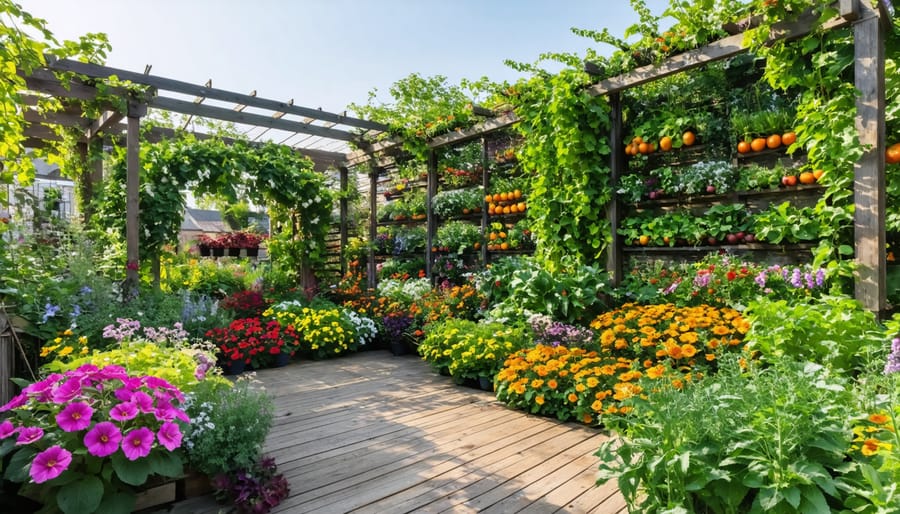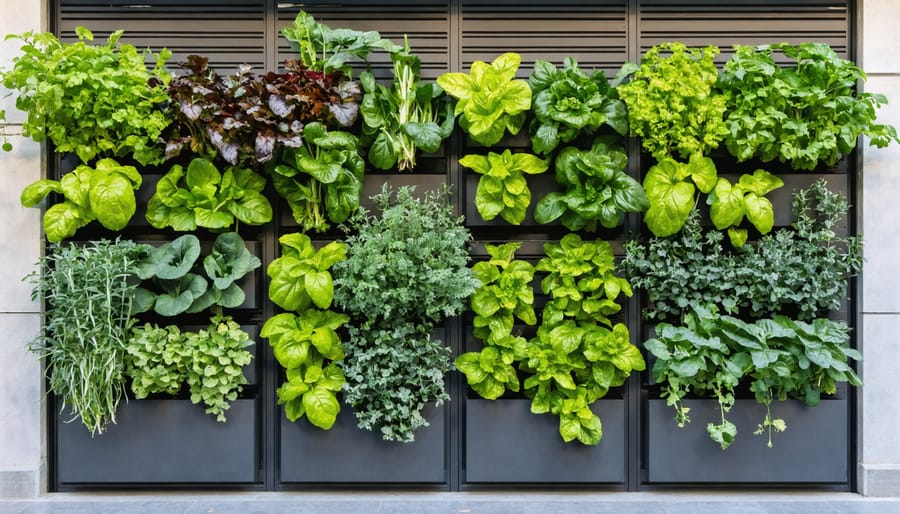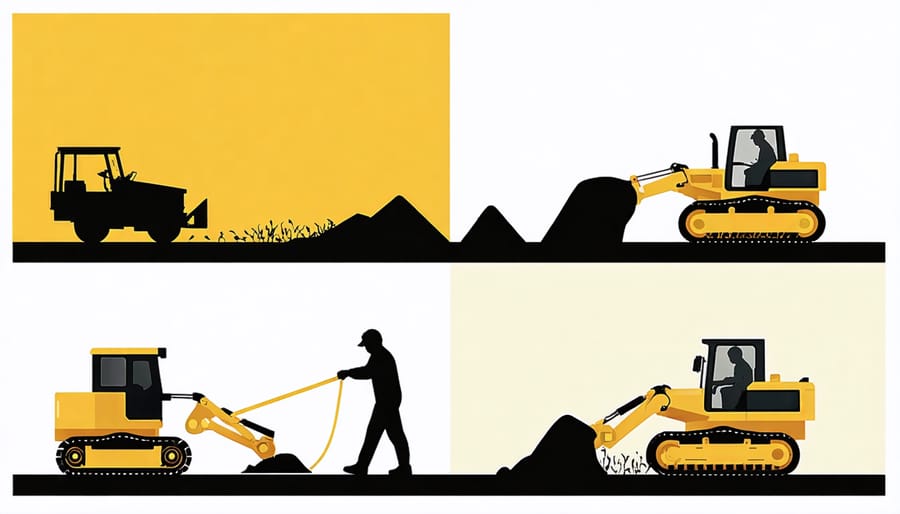Transform Your Backyard Into a Beautiful, Edible Paradise

Transform your empty lawn into a stunning edible landscape that seamlessly blends transform your backyard space into a productive food garden. Design vertical growing spaces using decorative trellises for climbing vegetables like peas and beans, while incorporating flowering herbs as natural borders. Layer fruit trees as anchor points, surrounded by attractive perennial vegetables and edible flowers that provide year-round visual interest. Group plants according to their water needs and sun requirements, creating distinct garden rooms that maximize both harvest potential and aesthetic appeal. Strategic placement of raised beds along pathways adds architectural elements while making maintenance and harvesting effortless. This innovative approach to landscaping not only elevates your property’s visual appeal but also provides fresh, organic produce steps from your kitchen. By focusing on edible plants that offer both beauty and functionality, you’ll create a sustainable, productive landscape that serves as both a peaceful retreat and a practical food source.
Planning Your Edible Landscape Design
Assessing Your Space and Sunlight
Before planting your edible garden, take time to analyze your available space and sunlight conditions. Start by creating a simple map of your yard, noting areas that receive full sun (6+ hours daily), partial sun (4-6 hours), and shade. Most fruits and vegetables need full sun to thrive, making these prime spots for eco-friendly garden layouts.
Consider your yard’s topography and drainage patterns. Observe how water flows during rainfall and identify any low spots where water collects. Most edible plants prefer well-draining soil, so these areas might need amendments or raised beds. Take note of existing structures like fences, trees, and buildings that cast shadows throughout the day.
Don’t forget to factor in accessibility. Ensure paths between planting areas are wide enough for comfortable maintenance and harvesting. If space is limited, look up – vertical gardening solutions can maximize your growing area while maintaining an attractive landscape design. Remember, even small spaces can yield impressive harvests when properly planned and utilized.

Combining Ornamental and Edible Plants
Creating beautiful combinations of ornamental and edible plants is both an art and a practical approach to maximizing your garden space. Start by selecting plants with complementary colors and textures – for instance, pair the deep purple leaves of ornamental kale with the silvery foliage of sage, or combine the striking height of sunflowers with cascading cherry tomatoes.
Consider using edible flowers like nasturtiums, calendula, and borage, which add splashes of color while being completely consumable. These not only enhance your garden’s visual appeal but also attract beneficial pollinators to your vegetable plants.
Herbs are perfect bridge plants between ornamental and edible gardens. Plant lavender, thyme, and oregano as border plants or in clusters among flowering perennials. Their varied textures and fragrances create sensory interest while providing fresh herbs for your kitchen.
Vertical elements can be achieved by training climbing edibles like pole beans or grape vines alongside ornamental climbers. Use decorative trellises or archways to create stunning garden features that produce food. For ground cover, consider spreading strawberries or creeping thyme between stepping stones.
Container groupings offer endless possibilities for combining beauty and function. Mix colorful Swiss chard with trailing petunias, or pair compact bush tomatoes with marigolds and basil. These combinations not only look stunning but also support each other’s growth through companion planting benefits.
Remember to maintain proper spacing and consider each plant’s mature size to ensure your combinations remain attractive throughout the growing season. With thoughtful planning, your edible landscape can be just as beautiful as any ornamental garden while providing fresh, homegrown produce.
Essential Elements of an Edible Landscape
Vertical Growing Solutions
When space is at a premium in your edible garden, growing vertically is a game-changer. By utilizing vertical space, you can double or even triple your growing area while creating stunning visual elements that enhance your landscape’s appeal. Start with sturdy trellises against walls or fences to support climbing vegetables like pole beans, peas, and cucumbers. These vertical structures can be beautifully illuminated with strategic outdoor lighting solutions to create dramatic evening displays.
Consider installing decorative arbors over garden pathways, which not only add architectural interest but provide perfect support for grape vines, kiwis, or flowering climbers like nasturtiums. Wall-mounted growing systems and pocket planters make excellent use of vertical surfaces for herbs and compact vegetables like lettuce and strawberries.
For maximum space efficiency, try using cattle panels curved into archways – these durable supports can handle heavier crops like squash and melons while creating charming garden tunnels. Don’t forget to incorporate tiered planters or step-style shelving units, which work wonderfully for cascading plants like cherry tomatoes or trailing herbs.
Remember to position your vertical structures thoughtfully to avoid shading other plants and to create visual interest throughout the seasons. With proper planning, your vertical growing elements can serve as both productive growing spaces and stunning focal points in your edible landscape.

Incorporating Fruit Trees and Shrubs
Fruit trees and shrubs can serve as stunning focal points in your edible landscape while providing delicious harvests throughout the year. Consider dwarf fruit trees like apples, pears, or cherries as natural alternatives to ornamental trees – they offer beautiful spring blossoms, summer shade, and fall color along with their bounty.
Strategic placement is key to success. Plant larger fruit trees along property boundaries or as natural privacy screens, while keeping smaller varieties like dwarf peaches or plums closer to walkways and patios where they can be easily appreciated and harvested. Espaliered fruit trees trained against walls or fences create living art that maximizes space efficiency.
Berry-producing shrubs like blueberries and raspberries make excellent hedges or border plantings, offering year-round structure with seasonal flowers and fruits. Incorporate ornamental features like trellises or archways to support climbing fruits like grapes or kiwis, creating dramatic vertical elements in your garden design.
Remember to consider the mature size of your fruit trees and their sunlight requirements when planning. Most fruit trees need full sun to produce well, so position them where they won’t cast unwanted shade on other plants. Group trees with similar water and care needs together for easier maintenance, and consider adding complementary understory plants like herbs or flowers to create beautiful, productive guilds around your fruit trees.
Herb Gardens and Borders
Herb gardens offer the perfect blend of beauty and functionality in your edible landscape. By strategically placing herbs along borders, walkways, or in dedicated garden beds, you create aromatic boundaries that serve both your kitchen and your garden’s aesthetic appeal.
Consider creating tiered herb gardens using raised beds or terraced layouts, with taller herbs like rosemary and sage at the back, medium-height plants like basil and oregano in the middle, and low-growing herbs such as thyme and creeping varieties along the edges. This arrangement not only looks visually appealing but also makes harvesting easier.
Mix herbs with complementary flowers to enhance visual interest while supporting beneficial insects. Purple sage pairs beautifully with lavender, while the delicate white flowers of cilantro complement colorful nasturtiums. For year-round appeal, incorporate both annual and perennial herbs into your design.
Container gardens offer flexibility in herb placement and make excellent focal points near entertaining areas or kitchen doors. Use decorative pots of varying heights and arrange them in groups of three for maximum visual impact. Consider hanging planters for trailing herbs like oregano or mint, which can become invasive if planted directly in the ground.
Remember to group herbs with similar water and sunlight needs together. This not only ensures healthy growth but also creates naturally harmonious planting combinations that look intentional and professionally designed.
Maintaining Your Edible Landscape
Seasonal Care and Harvesting
Successful edible landscaping requires attention to seasonal changes and timely harvesting practices. In spring, focus on soil preparation and planting early crops like peas, lettuce, and spring herbs. Add a fresh layer of compost and mulch to protect new plantings and retain moisture. Monitor emerging plants for pest issues and address them early using organic methods.
Summer brings peak growth and the first major harvests. Regular watering is crucial, preferably in the early morning or evening. Maintain consistent moisture levels using drip irrigation or soaker hoses to prevent stress on plants. Support heavy-fruiting plants like tomatoes and train climbing vegetables on trellises to maximize space and maintain garden aesthetics.
Fall is harvest season for many crops, especially root vegetables and winter squash. Begin preparing perennial plants for winter by reducing fertilization and water gradually. Clean up fallen fruit and vegetables to prevent pest problems. Plant cold-hardy varieties and install season extenders like row covers or cold frames to prolong the growing season.
Winter focuses on protection and planning. Apply thick mulch around perennial plants and install wind barriers if needed. Use this time to maintain tools, order seeds, and plan next season’s layout. Some cold-hardy crops like kale and Brussels sprouts can continue producing through winter with proper protection.
For harvesting, timing is everything. Pick leafy greens early in the morning when they’re crisp. Harvest fruits and vegetables when they reach full color and proper size – slightly underripe is better than overripe for most crops. Regular harvesting encourages continued production and maintains the garden’s neat appearance. Store tools nearby for convenient harvesting and maintenance, and keep a harvest basket handy for collecting produce.
Remember to record planting and harvest dates to improve timing for next season. This helps create a sustainable cycle of production while maintaining your garden’s visual appeal throughout the year.

Storage Solutions for Tools and Supplies
Keeping your edible garden tools and supplies organized is crucial for maintaining an efficient and enjoyable gardening experience. A well-planned storage system not only protects your investments but also makes your gardening tasks more pleasant and productive.
Start by categorizing your tools based on frequency of use. Daily items like pruning shears, trowels, and watering cans should be easily accessible, while seasonal storage solutions can accommodate items like cold frames, row covers, and specialized harvesting tools.
Consider installing a combination of storage options to meet different needs. A weather-resistant garden shed serves as your primary storage hub, while wall-mounted tool racks and pegboards maximize vertical space. Incorporate adjustable shelving units for storing seed packets, plant markers, and smaller accessories. Clear, labeled containers help organize seeds, fertilizers, and soil amendments while protecting them from moisture and pests.
For frequently used items, create convenient storage stations throughout your garden. Weather-resistant deck boxes or decorative containers can house tools near your main growing areas. Install hooks under covered areas for hanging harvest baskets and garden aprons.
Remember to include a potting station with dedicated storage for soil, containers, and transplanting supplies. A mobile cart or workbench with built-in storage compartments allows you to move supplies where needed while keeping everything organized.
Maintain your storage areas by implementing a regular cleaning and organization schedule. After each growing season, inspect, clean, and oil tools before storing them. This practice extends their lifespan and ensures they’re ready for the next season. Consider adding a small dehumidifier or moisture-absorbing packets in enclosed storage spaces to prevent rust and mildew.
By creating an organized storage system, you’ll spend less time searching for tools and more time enjoying your productive and beautiful edible landscape.
Creating an edible landscape is more than just growing food – it’s about crafting a living masterpiece that nourishes both body and soul. By blending ornamental and edible plants, you’ve discovered a way to make your outdoor space work harder while looking more beautiful than ever. The benefits are truly remarkable: fresh, organic produce steps from your kitchen, reduced grocery bills, enhanced property value, and the satisfaction of growing your own food in a visually stunning setting.
Remember that your edible landscape can start small. Begin with a few herb plants nestled among your existing flowers, or replace a purely decorative shrub with a fruit-bearing alternative. As your confidence grows, so too can your edible garden. The joy of harvesting sun-ripened tomatoes alongside blooming marigolds or picking fresh berries while admiring their spring blossoms is an experience that can’t be replicated.
Don’t let perfectionism hold you back – gardening is a journey of continuous learning and discovery. Each season brings new opportunities to experiment with different plant combinations and design elements. Your edible landscape will evolve with your needs and preferences, becoming more beautiful and productive with time.
Take that first step today. Start planning your edible landscape, and join the growing community of homeowners who have transformed their yards into beautiful, productive spaces that feed both the body and the soul.

